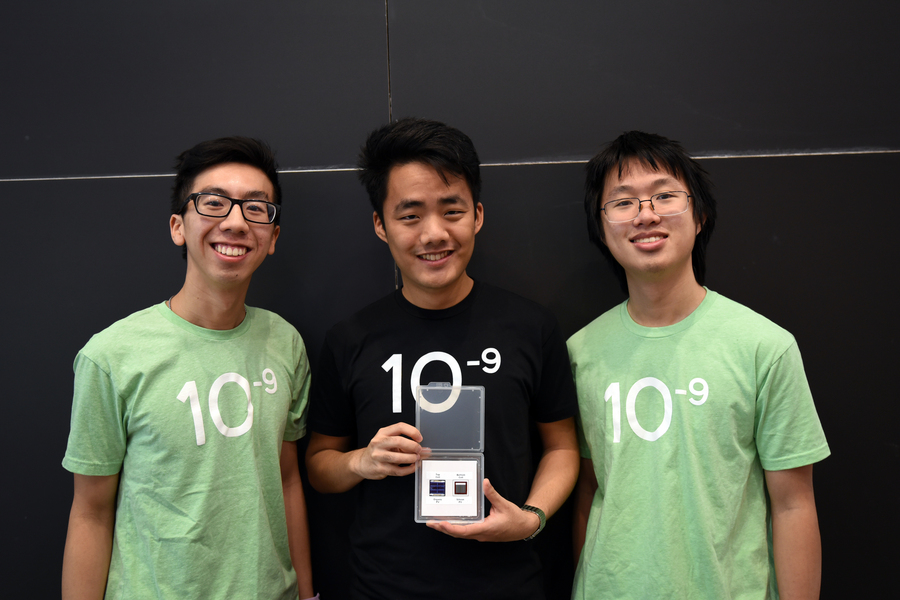MIT undergraduates are learning about nanoscale science and engineering from individual atoms up to full-scale functional systems, and they’re doing it hands-on at MIT.nano.
In class 6.2540 (Nanotechnology: From Atoms to Systems) students spend over nine weeks inside MIT.nano’s labs, learning basic skills that allow them to apply their knowledge of the nanoscale to design and build spectrometers, make quantum dots, fabricate light-emitting diodes (LEDs) and tunneling chemical sensors, and test and package their sensors into active displays and systems.
Bringing the science to life in this way has generated much excitement among the undergraduates. Dahlia Dry, a senior majoring in physics, said her faculty advisor suggested the class would show her the fun in quantum mechanics. “He was right. This class was exactly what middle-school-aged me thought MIT would be like, in all the best ways,” she says.
Word must be getting out about the fun as the class is drawing interest from undergraduates majoring in many different subjects. In fall 2022, six academic departments were represented by the 23 students enrolled.
“This class is quintessentially an ‘MIT’ class,” says Neil Deshmukh, an EECS junior. “Since coming to campus, I've always wanted to take a class where we were free to build nearly any idea, with access to state-of-the-art equipment and amazing instructors. In 6.2540, that's exactly what we did, and it was one of the best experiences I've had.”
The class is taught by three EECS professors: Farnaz Niroui, the EE Landsman Career Development Assistant Professor; Rajeev Ram, professor of electrical engineering; and Tayo Akinwande, the Thomas and Gerd Perkins Professor of Electrical Engineering and Computer Science.
“In this class we take a design approach, rather than the more common abstract and theoretical style,” explains Niroui. “We teach the fundamentals of quantum mechanics and nanoscale science by directly relating them to the design and engineering of diverse technologies.”
For this reason, the lectures are closely integrated with design projects and weekly lab modules. Starting the very first week, the students are inside the lab, learning to work in a cleanroom and acquiring the basic nanofabrication, processing, and characterization skills to investigate and implement concepts they have learned in the lectures — from fundamental science to material synthesis, device design, and full systems integration.
Rather than watching staff run the equipment, the undergraduates do the work themselves using simplified engineering and fabrication flows. “This was the most fascinating class I have taken at MIT, and that's despite it being in an area that I knew nothing about beforehand,” says EECS sophomore Eric Zhang. “It opened my eyes to an entire research and engineering field that I would never have known about otherwise.”
Each week’s lab work builds off the ones before, starting at the nano- and micro-level and building up to full-scale devices. Students learn about light-matter interactions and build their own microscopes and spectrometers, then use their new tools to characterize the materials and devices they make throughout the term. Further into the semester, they investigate the power of quantum mechanics and the design of nanomaterials through chemical synthesis of quantum dots, tuning their emission color by controlling their size. The following week, they use quantum dots to design and make an LED. This lab is followed by design and fabrication of a quantum tunneling chemical sensor based on graphene-polymer composites. In the final lab, the students use these LEDs and tunneling sensors to integrate a pixelated LED display into a handheld sensor-display system.
For their end-of-semester projects, the students split into teams to design and build something entirely from scratch, provided their idea uses the science, materials, and techniques covered in the class and has at least one feature smaller than 100 nanometers. In the fall 2022 semester, the undergraduates fabricated memristors for next-generation unconventional computing; nature-inspired structured lenses to improve LED efficiency; flexible graphene supercapacitors for solar energy storage; a flexible pulse oximeter; tandem solar cells based on band-gap engineering; and a transistor using atomically-thin 2D materials.
In addition to hands-on experience using tools for nanoscale engineering inside MIT.nano’s cleanroom and other labs, 6.2540 provides the opportunity for undergraduates to present at the Microsystems Annual Research Conference (MARC), co-sponsored by the Microsystems Technology Laboratories and MIT.nano. The long-standing event, which brings together over 200 MIT faculty, students, and industry partners each year, traditionally features graduate-level research.












